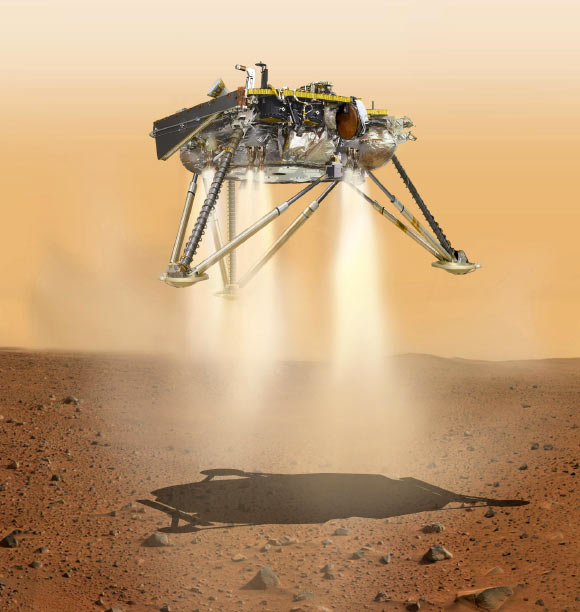NASA’s Mars Interior Exploration using Seismic Investigations, Geodesy and Heat Transport (InSight) lander is scheduled to touch down on the Red Planet at approximately 3 p.m. EST (12 p.m. PST, 8 p.m. GMT) on November 26, 2018.
Blasted off from Vandenberg Air Force Base in Central California on May 5, 2018, InSight marks NASA’s first Mars landing since the Curiosity rover in 2012.
The landing will kick off a two-year mission in which InSight will become the first spacecraft to study Mars’ deep interior. Its data also will help planetary researchers understand the formation of all rocky worlds, including our own.
“Landing on Mars is hard. It takes skill, focus and years of preparation,” said Dr. Thomas Zurbuchen, associate administrator for the Science Mission Directorate at NASA Headquarters in Washington.
“Keeping in mind our ambitious goal to eventually send humans to the surface of the Moon and then Mars, I know that our incredible science and engineering team — the only in the world to have successfully landed spacecraft on the Martian surface — will do everything they can to successfully land InSight on the Red Planet.”
Engineers at NASA’s Jet Propulsion Laboratory are preparing for the spacecraft to enter the Martian atmosphere, descend with a parachute and retrorockets, and touch down today at around 3 p.m. EST (12 p.m. PST, 8 p.m. GMT).

This is an illustration showing a simulated view of NASA’s InSight lander about to land on the surface of Mars. Image credit: NASA / JPL-Caltech.
InSight will hit the top of the Martian atmosphere at 12,300 mph (19,800 kph) and slow down to 5 mph (8 kph) before its three legs touch down on Martian soil.
“There’s a reason engineers call landing on Mars ‘seven minutes of terror’,” said Dr. Rob Grover, InSight’s entry, descent and landing (EDL) lead, based at NASA’s Jet Propulsion Laboratory.
“We can’t joystick the landing, so we have to rely on the commands we pre-program into the spacecraft. We’ve spent years testing our plans, learning from other Mars landings and studying all the conditions Mars can throw at us.”
“And we’re going to stay vigilant till InSight settles into its home in the Elysium Planitia region.”
Before InSight enters the atmosphere of the Red Planet, there are a few final preparations to make.
At 4:47 a.m. EST (1:47 a.m. PST, 9:47 a.m. GMT) engineers successfully conducted a last trajectory correction maneuver to steer the spacecraft within a few miles of its targeted entry point over Mars.
About two hours before hitting the atmosphere, the EDL team might also upload some final tweaks to the algorithm that guides the spacecraft safely to the surface. These will be the last commands issued to InSight before it robotically guides itself the rest of the way.
“It’s taken more than a decade to bring InSight from a concept to a spacecraft approaching Mars — and even longer since I was first inspired to try to undertake this kind of mission,” said InSight principal investigator Dr. Bruce Banerdt, of NASA’s Jet Propulsion Laboratory.
“But even after landing, we’ll need to be patient for the science to begin.”
It will take two to three months for InSight’s robotic arm to set the mission’s instruments on the surface.
During that time, engineers will monitor the environment and photograph the terrain in front of the lander.
“We’ve studied Mars from orbit and from the surface since 1965, learning about its weather, atmosphere, geology and surface chemistry,” said Dr. Lori Glaze, acting director of the Planetary Science Division in NASA’s Science Mission Directorate.
“Now we finally will explore inside Mars and deepen our understanding of our terrestrial neighbor as NASA prepares to send human explorers deeper into the Solar System.”








